The Treatment of Psychotic and Bipolar Disorders Within the South African Context: Perspectives of a Clinical Pharmacist
Abstract
1. Introduction
2. Methods and Materials
2.1. Research Setting
2.2. Inclusion/Exclusion Criteria
2.3. Participants
2.4. Data Collection Instrument and Process
- Section A: Patient Database. This includes demographic information, current and past medical history, and behavioural/lifestyle information. The patient was assigned a study number in this section.
- Section B: Current Medication List. The aim was to assess the prescribed medication and compare it to what the guidelines on the treatment of the condition said, with the intent of optimising the patient’s pharmacotherapy.
- Section C: Medication Therapy Assessment. This included assessing any medication-related problems with the use of guided questions that the researcher should review every day and use to monitor the patient.
- Section D: This section included the implemented interventions and evaluated the outcomes of those interventions.
2.5. Data Analysis
2.6. Ethical Considerations
3. Results
3.1. Demographic and Health Characteristics of Study Participants
3.2. Comorbidities
3.3. Prevalence of Psychiatric Disorders
3.4. Adherence to Treatment Guidelines
3.5. Medication-Related Challenges
3.5.1. Missed Doses
3.5.2. Drug Interactions
3.5.3. Inappropriate Dosage
3.5.4. Medications Prescribed Without Indications
3.6. Clinical Pharmacist-Led Interventions
4. Discussion
Strengths and Limitations of the Study
5. Conclusions
Author Contributions
Funding
Institutional Review Board Statement
Informed Consent Statement
Data Availability Statement
Acknowledgments
Conflicts of Interest
Appendix A
Appendix A.1. The Data Collection Instrument (Pharmaceutical Care Form) Used in This Study as Mentioned in Section 2.4 [14]

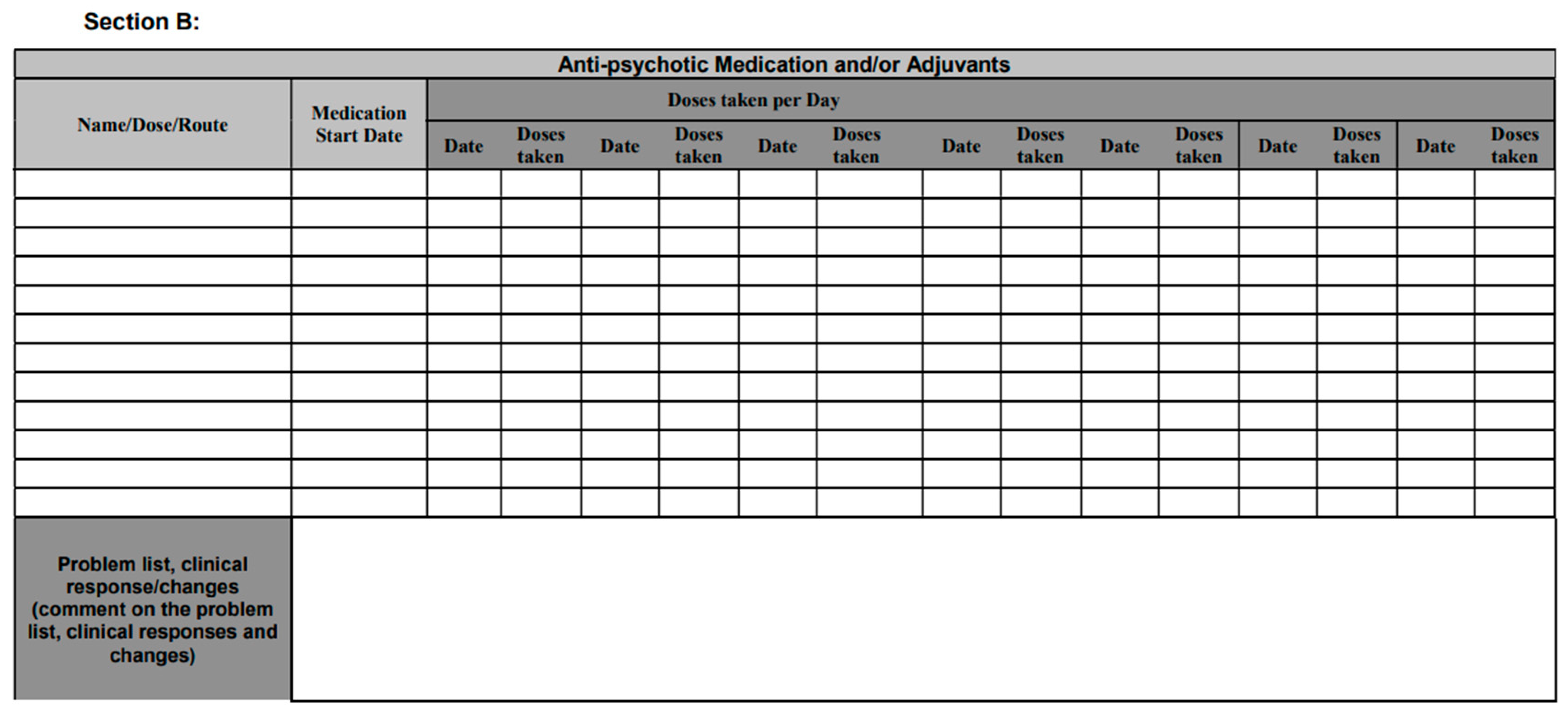
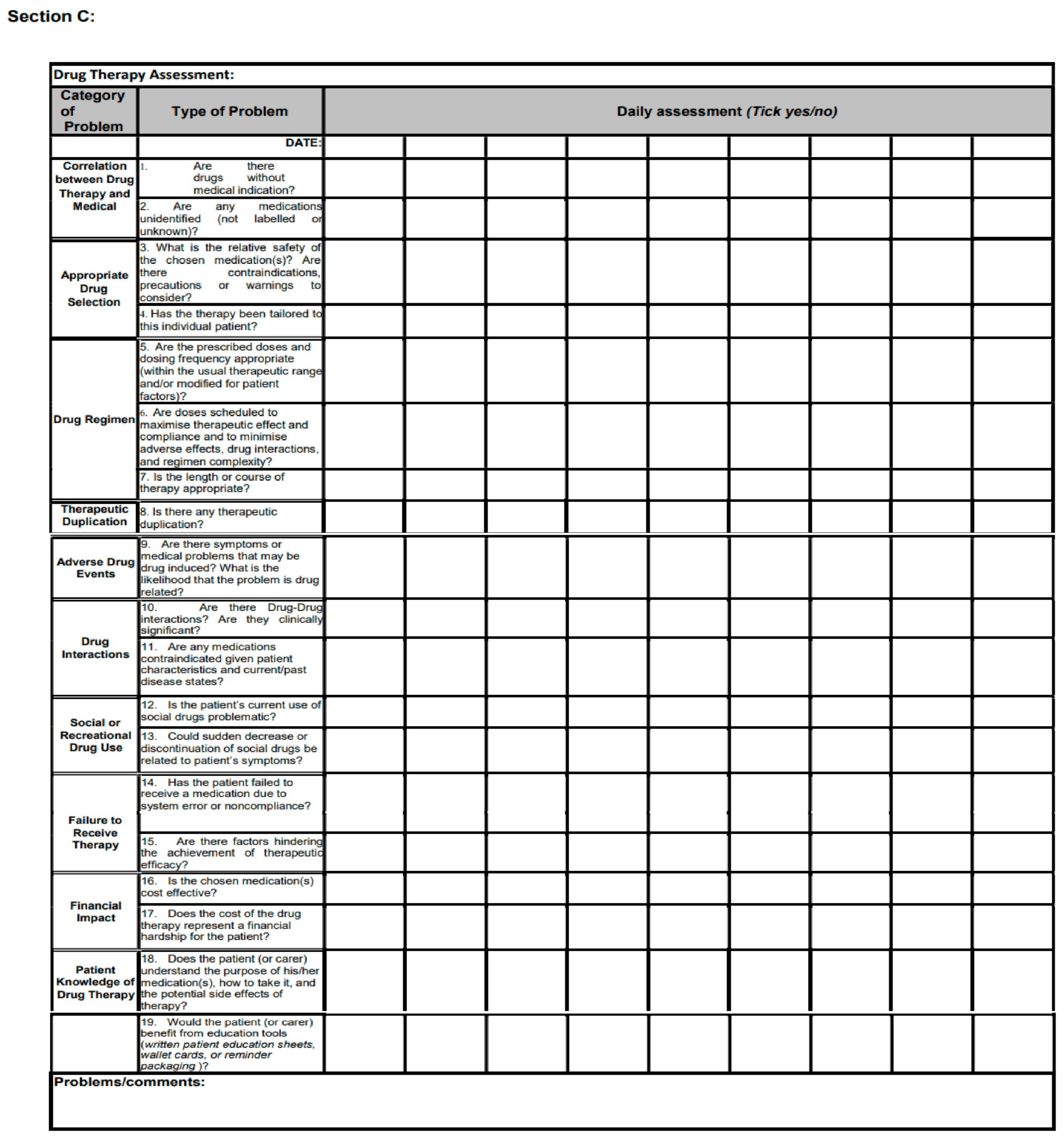

References
- Arciniegas, D.B. Psychosis. Contin. Lifelong Learn. Neurol. 2015, 21, 715. [Google Scholar] [CrossRef] [PubMed]
- Jain, A.; Mitra, P. Bipolar Affective Disorder; Europe PMC: Cambridge, UK, 2020. [Google Scholar]
- Martinotti, G.; Fornaro, M.; De Berardis, D. Comorbidity in bipolar disorder and schizophrenia, volume III. Front. Media SA 2024, 14, 1356817. [Google Scholar] [CrossRef]
- Lieberman, J.A.; First, M.B. Psychotic disorders. New Engl. J. Med. 2018, 379, 270–280. [Google Scholar] [CrossRef]
- Haglili, O.; Sixsmith, A.; Star, A.P.; Shmueli, M.; O’Rourke, N. Perceived cognitive loss, symptomology, and psychological well-being with bipolar disorder. Int. J. Bipolar Disord. 2024, 12, 34. [Google Scholar] [CrossRef]
- Lim, W.; Arnold, D.M.; Bachanova, V.; Haspel, R.L.; Rosovsky, R.P.; Shustov, A.R.; Crowther, M.A. Evidence-based guidelines—An introduction. Hematol. Am. Soc. Hematol. Educ. Program 2008, 2008, 26–30. [Google Scholar] [CrossRef] [PubMed]
- Kredo, T.; Bernhardsson, S.; Machingaidze, S.; Young, T.; Louw, Q.; Ochodo, E.; Grimmer, K. Guide to clinical practice guidelines: The current state of play. Int. J. Qual. Health Care 2016, 28, 122–128. [Google Scholar] [CrossRef]
- Emsley, R.; Hawkridge, S.; Potocnik, F.C.; Seedat, S.; Flisher, A.J.; Stein, D.J.; Grobler, G.; Swingler, D.; Szabo, C.P. Introduction: The South African Society of Psychiatrists (SASOP) treatment guidelines for psychiatric disorders. S. Afr. J. Psychiatry 2013, 19, 134–135. [Google Scholar]
- Nutting, S.; Bruinsma, T.; Anderson, M.; Jolly, T. Psychotic and still tripping—Hallucinogen persisting perception disorder and first break psychosis in an adolescent. Int. J. Ment. Health Addict. 2021, 19, 2440–2442. [Google Scholar] [CrossRef]
- Mashaw, S.A.; Anwar, A.I.; Vu, J.N.; Thomassen, A.S.; Beesley, M.L.; Shekoohi, S.; Kaye, A.D. Novel and Emerging Treatments for Agitation in Schizophrenia and Bipolar Disorder. Healthcare 2025, 13, 932. [Google Scholar] [CrossRef]
- Alderman, C.P.; Lucca, J.M. Psychiatry and clinical pharmacy: A logical partnership. Indian J. Psychiatry 2017, 59, 138. [Google Scholar]
- Javelot, H.; Gitahy Falcao Faria, C.; Vandenberghe, F.; Dizet, S.; Langrée, B.; Le Maout, M.; Straczek, C.; Egron, A.; Erb, A.; Sujol, G. Clinical pharmacy in psychiatry: Towards promoting clinical expertise in psychopharmacology. Pharmacy 2021, 9, 146. [Google Scholar] [CrossRef] [PubMed]
- Zaal, R.J.; Jansen, M.M.P.M.; Duisenberg-van Essenberg, M.; Tijssen, C.C.; Roukema, J.A.; van den Bemt, P.M.L.A. Identification of drug-related problems by a clinical pharmacist in addition to computerized alerts. Int. J. Clin. Pharm. 2013, 35, 753–762. [Google Scholar] [CrossRef] [PubMed]
- Bronkhorst, E.; Gous, A.G.S.; Schellack, N. Practice guidelines for clinical pharmacists in middle to low income countries. Front. Pharmacol. 2020, 11, 978. [Google Scholar] [CrossRef]
- Bronkhorst, E. An Assessment of the Need of Pharmaceutical Services in the Intensive Care Unit and High Care Unit of Steve Biko Academic Hospital. Ph.D. Thesis, University of Limpopo, Polokwane, South Africa, 2014. [Google Scholar]
- De Jager, Z.; Schellack, N.; Gous, A.G.S. Optimising services by the clinical pharmacist in a neonatal intensive care unit of a tertiary hospital in Gauteng Province, South Africa: Optimizing hospital patient care. Afr. J. Phys. Health Educ. Recreat. Danc. 2015, 21, 377–387. [Google Scholar]
- Van der Linden, L.; Hias, J.; Walgraeve, K.; Flamaing, J.; Tournoy, J.; Spriet, I. Clinical pharmacy services in older inpatients: An evidence-based review. Drugs Aging 2020, 37, 161–174. [Google Scholar] [CrossRef] [PubMed]
- Madala-Witbooi, N.J.; Adeniyi, O.V. Demographic and clinical profiles of admitted psychiatric patients of the East London Mental Health Unit in the Eastern Cape, South Africa. Medicine 2019, 98, e18399. [Google Scholar] [CrossRef]
- Kaikoushi, K.; Middleton, N.; Chatzittofis, A.; Bella, E.; Alevizopoulos, G.; Karanikola, M. Socio-demographic and clinical characteristics of adults with psychotic symptomatology under involuntary admission and readmission for compulsory treatment in a referral psychiatric hospital in Cyprus. Front. Psychiatry 2021, 12, 602274. [Google Scholar] [CrossRef]
- Van Rensburg, A.B.J. Clinical profile of acutely ill psychiatric patients admitted to a general hospital psychiatric unit. Afr. J. Psychiatry 2007, 10, 159–163. [Google Scholar] [CrossRef][Green Version]
- Mudgal, V.; Rastogi, P.; Niranjan, V.; Razdan, R. Pattern, clinical and demographic profile of inpatient psychiatry referrals in a tertiary care teaching hospital: A descriptive study. Gen. Psychiatry 2020, 33, e100177. [Google Scholar] [CrossRef]
- Douzenis, A.; Seretis, D.; Nika, S.; Nikolaidou, P.; Papadopoulou, A.; Rizos, E.N.; Christodoulou, C.; Tsopelas, C.; Mitchell, D.; Lykouras, L. Factors affecting hospital stay in psychiatric patients: The role of active comorbidity. BMC Health Serv. Res. 2012, 12, 1–9. [Google Scholar] [CrossRef]
- Daré, L.O.; Bruand, P.-E.; Gérard, D.; Marin, B.; Lameyre, V.; Boumédiène, F.; Preux, P.-M. Co-morbidities of mental disorders and chronic physical diseases in developing and emerging countries: A meta-analysis. BMC Public Health 2019, 19, 304. [Google Scholar] [CrossRef] [PubMed]
- Tsai, H.-P.; Hou, P.-H.; Mao, F.-C.; Chang, C.-C.; Yang, W.-C.; Wu, C.-F.; Liao, H.-J.; Lin, T.-C.; Chou, L.-S.; Hsiao, L.-W. Risperidone exacerbates glucose intolerance, nonalcoholic fatty liver disease, and renal impairment in obese mice. Int. J. Mol. Sci. 2021, 22, 409. [Google Scholar] [CrossRef]
- Kessing, L.V.; Thomsen, A.F.; Mogensen, U.B.; Andersen, P.K. Treatment with antipsychotics and the risk of diabetes in clinical practice. Br. J. Psychiatry 2010, 197, 266–271. [Google Scholar] [CrossRef]
- Fang, C.E.H.; Rafey, M.F.; Cunningham, A.; Dinneen, S.F.; Finucane, F.M. Risperidone-induced type 2 diabetes presenting with diabetic ketoacidosis. Endocrinol. Diabetes Metab. Case Rep. 2018, 2018, 18-0031. [Google Scholar]
- Gaebel, W.; Weinmann, S.; Sartorius, N.; Rutz, W.; McIntyre, J.S. Schizophrenia practice guidelines: International survey and comparison. Br. J. Psychiatry 2005, 187, 248–255. [Google Scholar] [CrossRef] [PubMed]
- Kilbourne, A.M.; Beck, K.; Spaeth-Rublee, B.; Ramanuj, P.; O’Brien, R.W.; Tomoyasu, N.; Pincus, H.A. Measuring and improving the quality of mental health care: A global perspective. World Psychiatry 2018, 17, 30–38. [Google Scholar] [CrossRef]
- Bereda, G.; Bereda, G. Prevelance of drug related problems and its associated factors among schizophernic patients in psychiatric ambulatory clinic of Mettu Karl Referral Hospital, South Western, Ethiopia: A prospective cross sectional study. Int. J. Multidiscip. Educ. Res. 2021, 6, 40–45. [Google Scholar]
- Nosé, M.; Barbui, C.; Gray, R.; Tansella, M. Clinical interventions for treatment non-adherence in psychosis: Meta-analysis. Br. J. Psychiatry 2003, 183, 197–206. [Google Scholar] [CrossRef] [PubMed]
- Haddad, P.M.; Brain, C.; Scott, J. Nonadherence with antipsychotic medication in schizophrenia: Challenges and management strategies. Patient Relat. Outcome Meas. 2014, 5, 43–62. [Google Scholar] [CrossRef]
- Semahegn, A.; Torpey, K.; Manu, A.; Assefa, N.; Tesfaye, G.; Ankomah, A. Psychotropic medication non-adherence and its associated factors among patients with major psychiatric disorders: A systematic review and meta-analysis. Syst. Rev. 2020, 9, 17. [Google Scholar] [CrossRef]
- Cheragi, M.A.; Manoocheri, H.; Mohammadnejad, E.; Ehsani, S.R. Types and causes of medication errors from nurse’s viewpoint. Iran. J. Nurs. Midwifery Res. 2013, 18, 228. [Google Scholar] [PubMed]
- Aburamadan, H.A.R.; Sridhar, S.B.; Tadross, T.M. Assessment of potential drug interactions among psychiatric inpatients receiving antipsychotic therapy of a secondary care hospital, United Arab Emirates. J. Adv. Pharm. Technol. Res. 2021, 12, 45. [Google Scholar] [CrossRef] [PubMed]
- Spina, E.; Avenoso, A.; Facciolà, G.; Salemi, M.; Scordo, M.G.; Giacobello, T.; Madia, A.G.; Perucca, E. Plasma concentrations of risperidone and 9-hydroxyrisperidone: Effect of comedication with carbamazepine or valproate. Ther. Drug Monit. 2000, 22, 481–485. [Google Scholar] [CrossRef]
- Procyshyn, R.M.; Barr, A.M.; Brickell, T.; Honer, W.G. Medication errors in psychiatry: A comprehensive review. CNS Drugs 2010, 24, 595–609. [Google Scholar] [CrossRef]
- de Silva, V.A.; Suraweera, C.; Ratnatunga, S.S.; Dayabandara, M.; Wanniarachchi, N.; Hanwella, R. Metformin in prevention and treatment of antipsychotic induced weight gain: A systematic review and meta-analysis. BMC Psychiatry 2016, 16, 341. [Google Scholar] [CrossRef] [PubMed]
- Hakami, A.Y.; Felemban, R.; Ahmad, R.G.; Al-Samadani, A.H.; Salamatullah, H.K.; Baljoon, J.M.; Alghamdi, L.J.; Ramadani Sindi, M.H.; Ahmed, M.E. The association between antipsychotics and weight gain and the potential role of metformin concomitant use: A retrospective cohort study. Front. Psychiatry 2022, 13, 914165. [Google Scholar] [CrossRef]
- Zheng, W.; Zhang, Q.-E.; Cai, D.-B.; Yang, X.-H.; Ungvari, G.S.; Ng, C.H.; Wu, R.-R.; Xiang, Y.-T. Combination of metformin and lifestyle intervention for antipsychotic-related weight gain: A meta-analysis of randomized controlled trials. Pharmacopsychiatry 2019, 52, 24–31. [Google Scholar] [CrossRef]
- Battini, V.; Van Manen, R.P.; Gringeri, M.; Mosini, G.; Guarnieri, G.; Bombelli, A.; Pozzi, M.; Nobile, M.; Radice, S.; Clementi, E. The potential antidepressant effect of antidiabetic agents: New insights from a pharmacovigilance study based on data from the reporting system databases FAERS and VigiBase. Front. Pharmacol. 2023, 14, 1128387. [Google Scholar] [CrossRef]
- Archibald, L.; Brunette, M.F.; Wallin, D.J.; Green, A.I. Alcohol use disorder and schizophrenia or schizoaffective disorder. Alcohol Res. Curr. Rev. 2019, 40, arcr.v40.1.06. [Google Scholar] [CrossRef]
- Stuhec, M.; Lah, L. Clinical pharmacist interventions in elderly patients with mental disorders in primary care focused on psychotropics: A retrospective pre–post observational study. Ther. Adv. Psychopharmacol. 2021, 11, 20451253211011007. [Google Scholar] [CrossRef]
- Stuhec, M.; Tement, V. Positive evidence for clinical pharmacist interventions during interdisciplinary rounding at a psychiatric hospital. Sci. Rep. 2021, 11, 13641. [Google Scholar] [CrossRef] [PubMed]
- Hannou, S.; Voirol, P.; Pannatier, A.; Weibel, M.-L.; Sadeghipour, F.; von Gunten, A.; Mall, J.-F.; De Giorgi Salamun, I. Pharmacist intervention acceptance for the reduction of potentially inappropriate drug prescribing in acute psychiatry. Int. J. Clin. Pharm. 2017, 39, 1228–1236. [Google Scholar] [CrossRef] [PubMed]
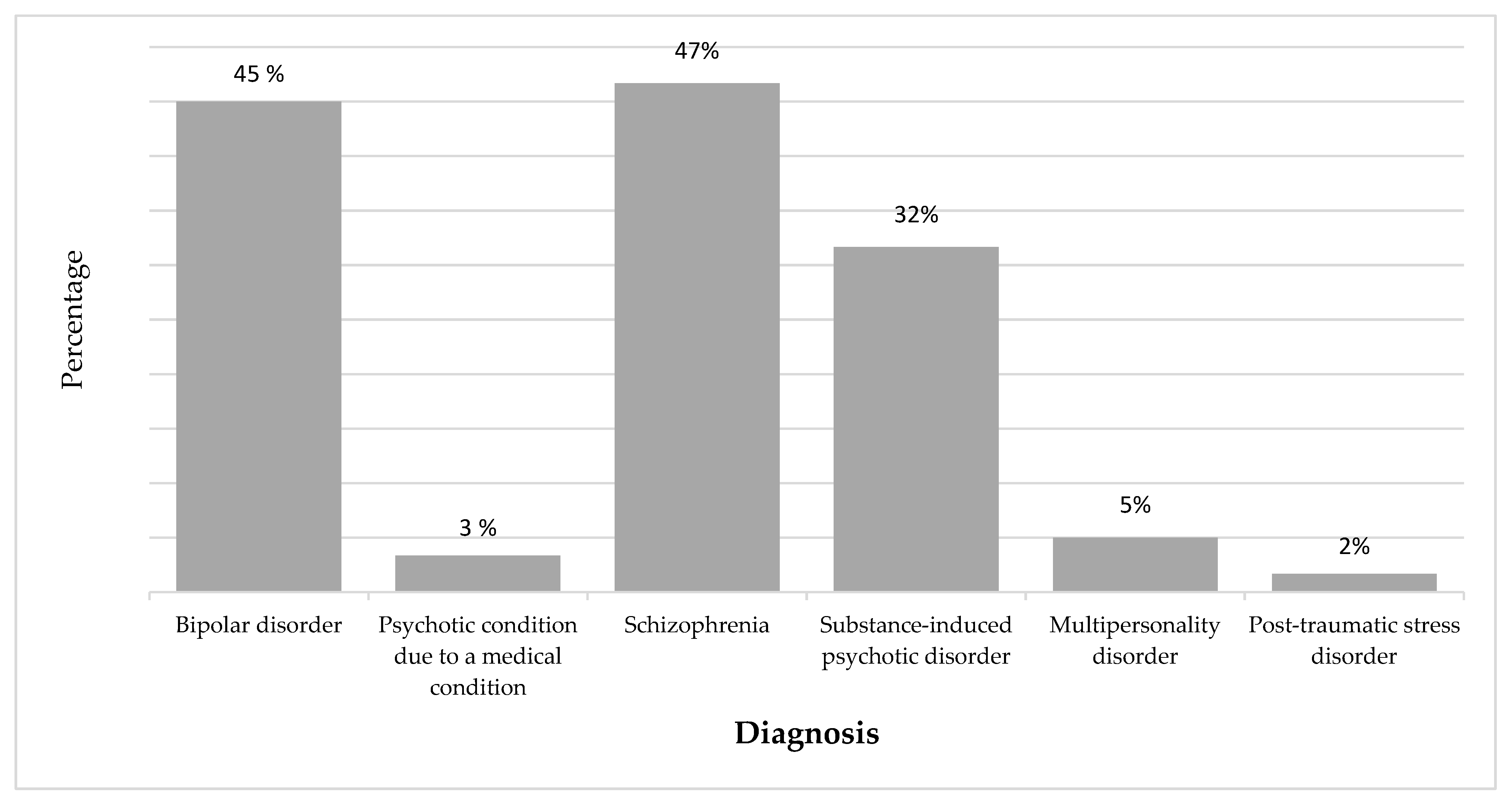
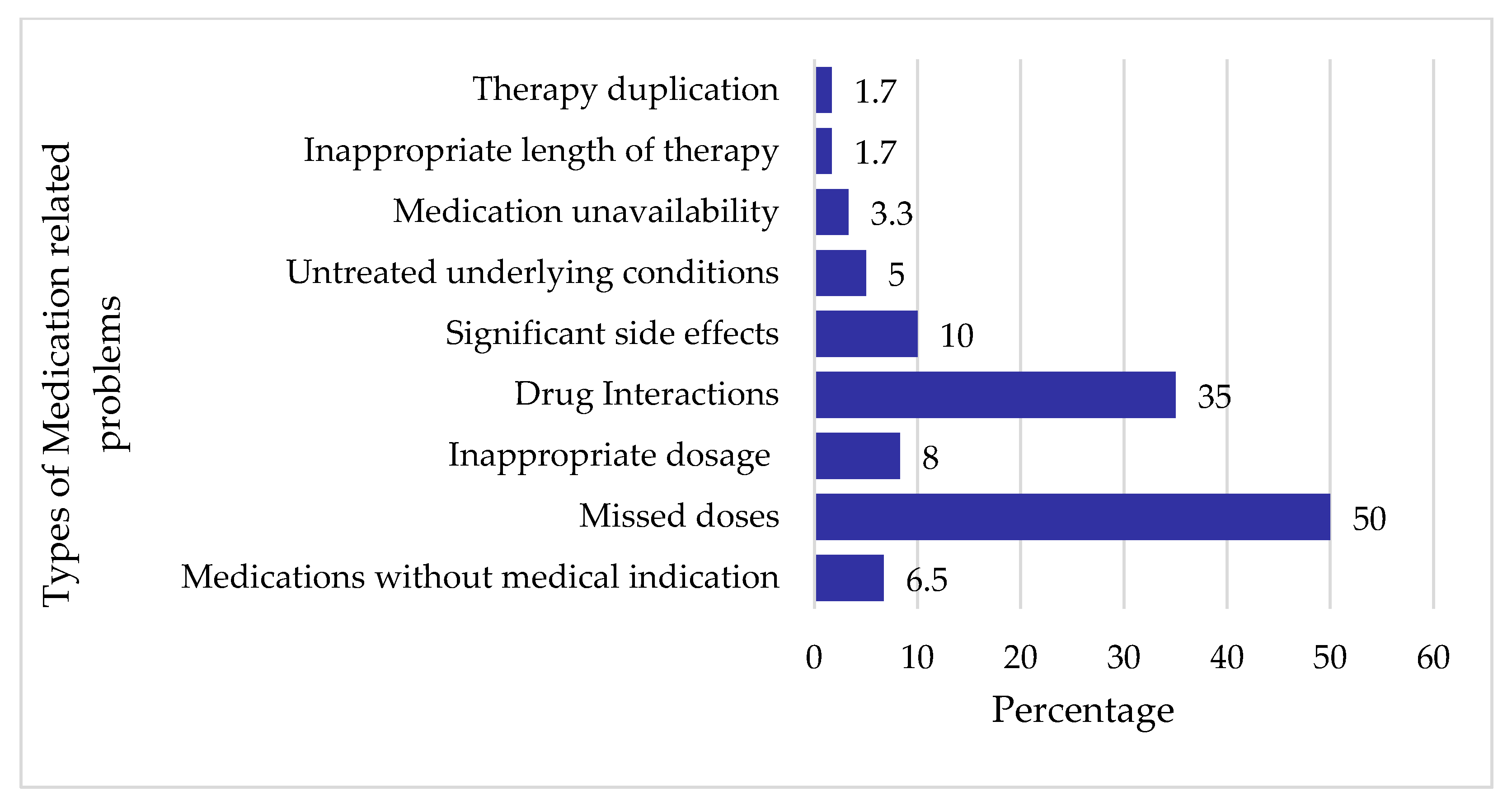
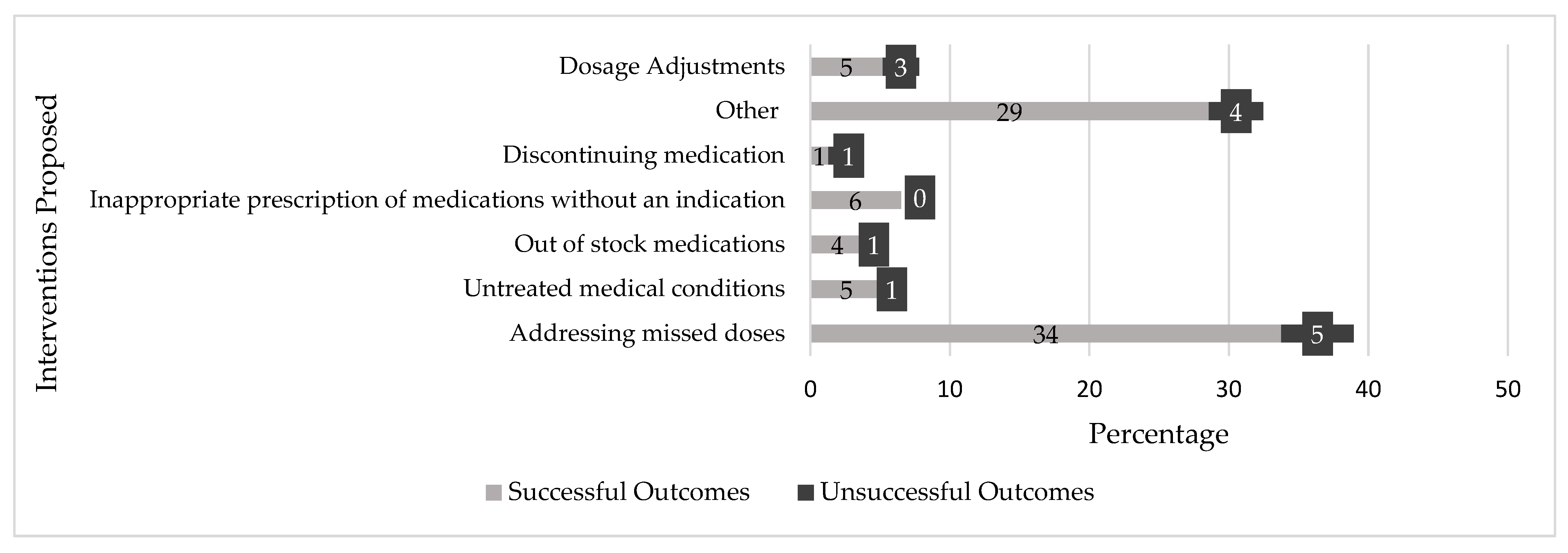
| Therapeutic Problem | Explanation | Monitoring/Outcome Measure |
|---|---|---|
| Lack of correlation between drug therapy and medical problems: inappropriate drug selection | Drugs without medical indications, unidentified medications, or untreated medical conditions, including any which require drug therapy. Comparative efficacy, safety, and appropriateness for the individual patient. | Discontinue or introduce drugs. Destroy unidentified medication. Limit side effects or adverse drug reactions. |
| Drug regimen | Inappropriate dose, dosing frequency, dosage form, route of administration (considering efficacy, safety, and convenience), or duration of therapy. | Optimise dose to reduce adverse drug reactions. Optimise the dosing regimen, including dose frequency, form, and route of administration. |
| Therapeutic duplication | The treatment of any condition with more types of medication than necessary. | Optimise dose to reduce adverse drug reactions. |
| Drug allergy or intolerance | Any medicines and methods used to alert healthcare providers to the allergy/intolerance. | Avoid hypersensitivity reactions. Ensure healthcare providers are aware of allergy. Identify and stop offending medicine. |
| Adverse drug events | Any possibly drug-related symptoms or medical problems, and the likelihood that the problem is drug-related. | Report ADR on pharmacovigilance form Identify interactions and discontinue/replace the identified drugs. Reduce adverse drug reactions. |
| Interactions | Drug–drug interactions, drug–disease interactions, drug–nutrient interactions, and drug–laboratory interactions. | Report ADR on pharmacovigilance form. Identify interaction and discontinue/replace identified drug. |
| Social or recreational drug use | Smoking or alcohol. Recreational drugs. | Identify problems caused by social drug use. |
| Failure to receive therapy | Reasons such as system errors or any other factors that could hinder the achievement of therapeutic efficacy. | Recommend optimal management. Ensure the availability of medicine supplies to patients. Address other factors or system errors. |
| Characteristics | Number | Percentage (%) |
|---|---|---|
| Total patients (n) | 60 | |
| Gender: | ||
| Female | 37 | 61.7 |
| Male | 23 | 38.3 |
| Age: | ||
| Mean (years) | 37 | - |
| Range (years) | 19–71 | - |
| Comorbidities | Frequency | Percentage % |
| Epilepsy | 2 | 3.3 |
| HIV positive | 5 | 8.3 |
| Hypertension | 9 | 15 |
| Peripheral vascular disease | 1 | 1.7 |
| Type 2 diabetes mellitus | 2 | 3.3 |
| No comorbidities | 41 | 68.3 |
| Compliance to NICE | Compliance to STG | Compliance to APA | |
|---|---|---|---|
| Frequency | 46 | 45 | 43 |
| Percentage (%) | 76 | 75 | 71 |
| Mode of Intervention | Sum of Frequency | Percentage (%) | Successful Outcomes from Interventions | Unsuccessful Outcomes from Interventions | Reason for Unsuccessful Outcome |
|---|---|---|---|---|---|
| Communication with the nurses | 54 | 70 | 51 | 3 | Administrative and process delays (2). Communication gaps (1). |
| Communication with the doctors | 21 | 27 | 13 | 8 | Doctor assurance of treatment plan (5). Administrative and process delays (3). |
| Written in the file communication | 2 | 3 | 1 | 1 | Communication not read (1). |
Disclaimer/Publisher’s Note: The statements, opinions and data contained in all publications are solely those of the individual author(s) and contributor(s) and not of MDPI and/or the editor(s). MDPI and/or the editor(s) disclaim responsibility for any injury to people or property resulting from any ideas, methods, instructions or products referred to in the content. |
© 2025 by the authors. Licensee MDPI, Basel, Switzerland. This article is an open access article distributed under the terms and conditions of the Creative Commons Attribution (CC BY) license (https://creativecommons.org/licenses/by/4.0/).
Share and Cite
Kahwenga, K.D.; Mnukwa, L.; Bronkhorst, E. The Treatment of Psychotic and Bipolar Disorders Within the South African Context: Perspectives of a Clinical Pharmacist. Healthcare 2025, 13, 1456. https://doi.org/10.3390/healthcare13121456
Kahwenga KD, Mnukwa L, Bronkhorst E. The Treatment of Psychotic and Bipolar Disorders Within the South African Context: Perspectives of a Clinical Pharmacist. Healthcare. 2025; 13(12):1456. https://doi.org/10.3390/healthcare13121456
Chicago/Turabian StyleKahwenga, Kudzai D., Lindiwe Mnukwa, and Elmien Bronkhorst. 2025. "The Treatment of Psychotic and Bipolar Disorders Within the South African Context: Perspectives of a Clinical Pharmacist" Healthcare 13, no. 12: 1456. https://doi.org/10.3390/healthcare13121456
APA StyleKahwenga, K. D., Mnukwa, L., & Bronkhorst, E. (2025). The Treatment of Psychotic and Bipolar Disorders Within the South African Context: Perspectives of a Clinical Pharmacist. Healthcare, 13(12), 1456. https://doi.org/10.3390/healthcare13121456






